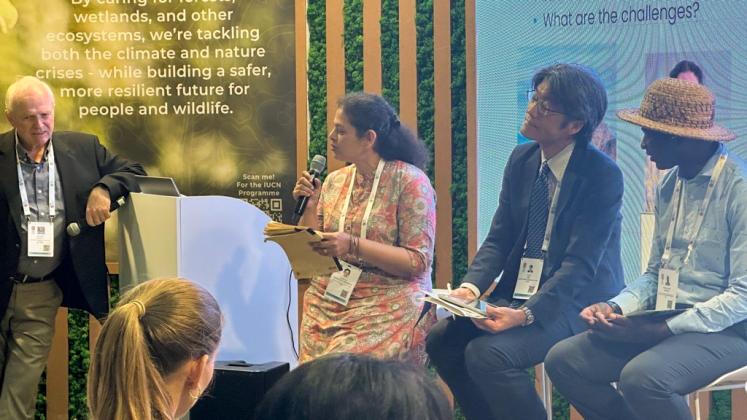On 10 October 2025, UNU-IAS co-organized a session at the IUCN World Conservation Congress 2025 held on 9–15 October in Abu Dhabi, highlighting biodiversity conservation efforts by non-state actors, including Indigenous Peoples and Local Communities (IPLCs), private entities and citizens. The event explored how Other Effective Area-based Conservation Measures (OECMs) can advance Target 3 of the Kunming-Montreal Global Biodiversity Framework, which aims to conserve 30% of global land and sea by 2030. It showcased the work of the International Partnership for the Satoyama Initiative (IPSI), focusing on inclusive governance, recognition challenges and equitable implementation strategies.
Opening the session, Atsuhiro Yoshinaka (Special Assistant to the Minister for Foreign Affairs, Ministry of Foreign Affairs of Japan) emphasized that Japan has supported OECMs since the implementation of the 2010 Nagoya Strategic Plan, building on the Satoyama Initiative and National Biodiversity Strategies and Action Plans (NBSAPs). Stephen Woodley (Vice Chair for Science, IUCN-WCPA) highlighted OECMs' origins in Indigenous and Community Conserved Areas (ICCAs), noting their shift toward technical, government-led frameworks and welcoming renewed focus on IPLCs. Prescilia Kapupu (Indigenous Expert, ANAPAC-DRC) underscored IPLCs’ role as biodiversity custodians, advocating for ICCA inclusion in OECMs due to their conservation impact. Takao Aiba (Chair of Planning Sub-committee, Keidanren Nature Conservation Council) discussed mobilizing private sector engagement in biodiversity-friendly practices in Japan and globally.
Discussing the role of non-state actors, Suneetha M. Subramanian (Research Fellow, UNU-IAS) pointed out that citizens, consumers and producers influence conservation outcomes through their choices. She discussed two case studies: in Colombia, Corporación Ambiental y Forestal del Pacifico (CORFOPAL) supports private landowners in designating ecological corridors, enabling them to balande trade-offs while retaining control, as documented in Satoyama Initiative Thematic Review (SITR) Volume 4. In Japan, the Kushiro watershed initiative engages NGOs, academia, farmers and citizens to promote stork-friendly rice production, supported by consumers’ willingness to pay premium prices.
She emphasized that while concerns such as greenwashing persist, managed landscapes can serve as effective OECMs when supported by sustainable practices, appropriate incentives and safeguards for IPLC tenure — a point echoed by Jasmin Upton (UNEP-WCMC), who called for broader IPLC and private sector representation in the global OECM database.
Audience questions highlighted concerns over OECM registration, including tenure uncertainties, limited financial access and potential loss of control by IPLCs and the private sector, emphasizing the need for inclusive engagement and incentives to ensure equitable, outcome-focused conservation.
The event was co-organized by UNU-IAS, the International Union for Conservation of Nature (IUCN) and the European Union (EU).


